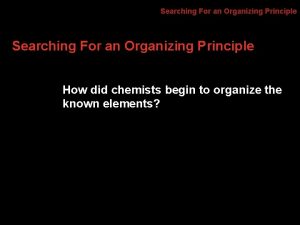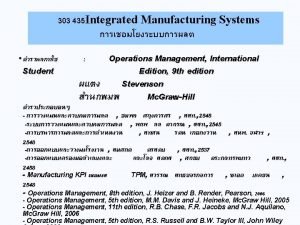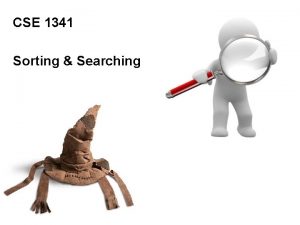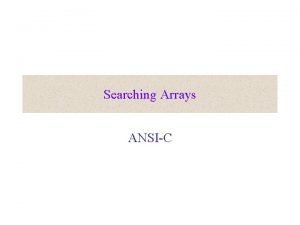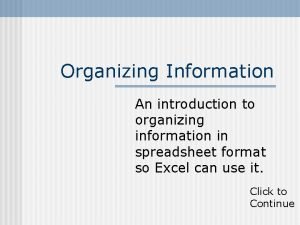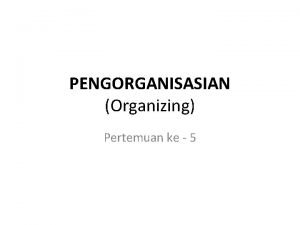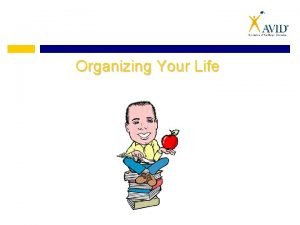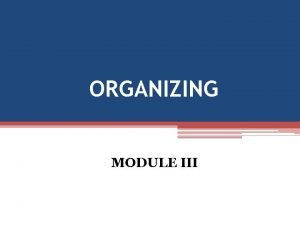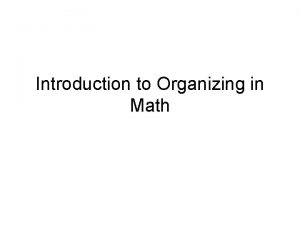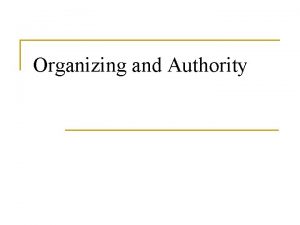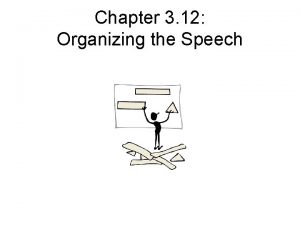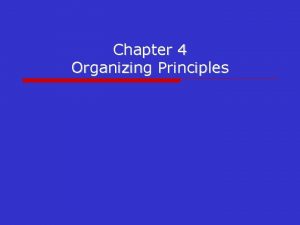6 1 Searching For an Organizing Principle How


























- Slides: 26

6. 1 Searching For an Organizing Principle How did chemists begin to organize the known elements?

6. 1 Searching For an Organizing Principle Chemists used the properties of elements to sort them into groups.

6. 1 Searching For an Organizing Principle Chlorine, bromine, and iodine have very similar chemical properties.

6. 1 Mendeleev’s Periodic Table How did Mendeleev organize his periodic table?

6. 1 Mendeleev’s Periodic Table Mendeleev arranged the elements in his periodic table in order of increasing atomic mass. The periodic table can be used to predict the properties of undiscovered elements.

6. 1 Mendeleev’s Periodic Table An Early Version of Mendeleev’s Periodic Table

6. 1 The Periodic Law How is the modern periodic table organized?

6. 1 The Periodic Law In the modern periodic table, elements are arranged in order of increasing atomic number.

6. 1 The Periodic Law The periodic law: When elements are arranged in order of increasing atomic number, there is a periodic repetition of their physical and chemical properties. • The properties of the elements within a period change as you move across a period from left to right. • The pattern of properties within a period repeats as you move from one period to the next.

6. 1 Metals, Nonmetals, and Metalloids What are three broad classes of elements?

6. 1 Metals, Nonmetals, and Metalloids Three classes of elements are metals, nonmetals, and metalloids. Across a period, the properties of elements become less metallic and more nonmetallic.

6. 1 Metals, Nonmetals, and Metalloids Metals, Metalloids, and Nonmetals in the Periodic Table

6. 1 Metals, Nonmetals, and Metalloids Metals, Metalloids, and Nonmetals in the Periodic Table

6. 1 Metals, Nonmetals, and Metalloids Metals, Metalloids, and Nonmetals in the Periodic Table

6. 1 Metals, Nonmetals, and Metalloids Metals, Metalloids, and Nonmetals in the Periodic Table

6. 1 Metals, Nonmetals, and Metalloids Metals are good conductors of heat and electric current. • 80% of elements are metals. • Metals have a high luster, are ductile, and are malleable.

6. 1 Metals, Nonmetals, and Metalloids Uses of Iron, Copper, and Aluminum

6. 1 Metals, Nonmetals, and Metalloids Uses of Iron, Copper, and Aluminum

6. 1 Metals, Nonmetals, and Metalloids Uses of Iron, Copper, and Aluminum

6. 1 Metals, Nonmetals, and Metalloids Nonmetals In general, nonmetals are poor conductors of heat and electric current. • Most nonmetals are gases at room temperature. • A few nonmetals are solids, such as sulfur and phosphorus. • One nonmetal, bromine, is a dark-red liquid.

6. 1 Metals, Nonmetals, and Metalloids A metalloid generally has properties that are similar to those of metals and nonmetals. The behavior of a metalloid can be controlled by changing conditions.

6. 1 Metals, Nonmetals, and Metalloids If a small amount of boron is mixed with silicon, the mixture is a good conductor of electric current. Silicon can be cut into wafers, and used to make computer chips.

6. 1 Section Quiz 1. The modern periodic table has elements arranged in order of a. colors. b. melting and boiling points. c. increasing atomic mass. d. increasing atomic number.

6. 1 Section Quiz 2. Mendeleev arranged the elements in his periodic table in order of increasing a. atomic number. b. number of protons. c. number of electrons. d. atomic mass

6. 1 Section Quiz 3. Which one of the following is NOT a general property of metals? a. ductility b. malleability c. having a high luster d. poor conductor of heat and electricity

END OF SHOW
 How did mendeleev organize his periodic table
How did mendeleev organize his periodic table Borra hål för knoppar
Borra hål för knoppar Bris för vuxna
Bris för vuxna Mat för idrottare
Mat för idrottare Sura för anatom
Sura för anatom Smärtskolan kunskap för livet
Smärtskolan kunskap för livet Frgar
Frgar Argument för teckenspråk som minoritetsspråk
Argument för teckenspråk som minoritetsspråk Etik och ledarskap etisk kod för chefer
Etik och ledarskap etisk kod för chefer Novell typiska drag
Novell typiska drag Ellika andolf
Ellika andolf Rita perspektiv
Rita perspektiv Blomman för dagen drog
Blomman för dagen drog Debattinlägg mall
Debattinlägg mall Redogör för vad psykologi är
Redogör för vad psykologi är Claes martinsson
Claes martinsson En lathund för arbete med kontinuitetshantering
En lathund för arbete med kontinuitetshantering Geometri för barn
Geometri för barn Svenskt ramverk för digital samverkan
Svenskt ramverk för digital samverkan Bunden form
Bunden form Klädsel i rom
Klädsel i rom Orubbliga rättigheter
Orubbliga rättigheter Förklara densitet för barn
Förklara densitet för barn Ministerstyre för och nackdelar
Ministerstyre för och nackdelar Bamse för de yngsta
Bamse för de yngsta Verktyg för automatisering av utbetalningar
Verktyg för automatisering av utbetalningar Nationell inriktning för artificiell intelligens
Nationell inriktning för artificiell intelligens
